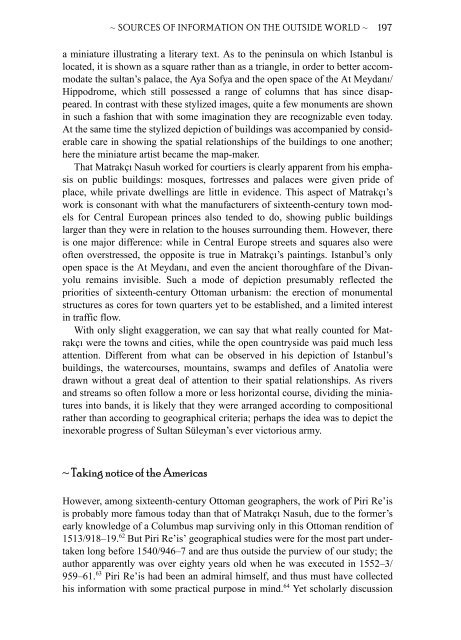The Ottoman Empire and the World Around It - Course Information
The Ottoman Empire and the World Around It - Course Information
The Ottoman Empire and the World Around It - Course Information
You also want an ePaper? Increase the reach of your titles
YUMPU automatically turns print PDFs into web optimized ePapers that Google loves.
~ SOURCES OF INFORMATION ON THE OUTSIDE WORLD ~ 197<br />
a miniature illustrating a literary text. As to <strong>the</strong> peninsula on which Istanbul is<br />
located, it is shown as a square ra<strong>the</strong>r than as a triangle, in order to better accommodate<br />
<strong>the</strong> sultan’s palace, <strong>the</strong> Aya Sofya <strong>and</strong> <strong>the</strong> open space of <strong>the</strong> At Meydanı/<br />
Hippodrome, which still possessed a range of columns that has since disappeared.<br />
In contrast with <strong>the</strong>se stylized images, quite a few monuments are shown<br />
in such a fashion that with some imagination <strong>the</strong>y are recognizable even today.<br />
At <strong>the</strong> same time <strong>the</strong> stylized depiction of buildings was accompanied by considerable<br />
care in showing <strong>the</strong> spatial relationships of <strong>the</strong> buildings to one ano<strong>the</strong>r;<br />
here <strong>the</strong> miniature artist became <strong>the</strong> map-maker.<br />
That Matrakçı Nasuh worked for courtiers is clearly apparent from his emphasis<br />
on public buildings: mosques, fortresses <strong>and</strong> palaces were given pride of<br />
place, while private dwellings are little in evidence. This aspect of Matrakçı’s<br />
work is consonant with what <strong>the</strong> manufacturers of sixteenth-century town models<br />
for Central European princes also tended to do, showing public buildings<br />
larger than <strong>the</strong>y were in relation to <strong>the</strong> houses surrounding <strong>the</strong>m. However, <strong>the</strong>re<br />
is one major difference: while in Central Europe streets <strong>and</strong> squares also were<br />
often overstressed, <strong>the</strong> opposite is true in Matrakçı’s paintings. Istanbul’s only<br />
open space is <strong>the</strong> At Meydanı, <strong>and</strong> even <strong>the</strong> ancient thoroughfare of <strong>the</strong> Divanyolu<br />
remains invisible. Such a mode of depiction presumably reflected <strong>the</strong><br />
priorities of sixteenth-century <strong>Ottoman</strong> urbanism: <strong>the</strong> erection of monumental<br />
structures as cores for town quarters yet to be established, <strong>and</strong> a limited interest<br />
in traffic flow.<br />
With only slight exaggeration, we can say that what really counted for Matrakçı<br />
were <strong>the</strong> towns <strong>and</strong> cities, while <strong>the</strong> open countryside was paid much less<br />
attention. Different from what can be observed in his depiction of Istanbul’s<br />
buildings, <strong>the</strong> watercourses, mountains, swamps <strong>and</strong> defiles of Anatolia were<br />
drawn without a great deal of attention to <strong>the</strong>ir spatial relationships. As rivers<br />
<strong>and</strong> streams so often follow a more or less horizontal course, dividing <strong>the</strong> miniatures<br />
into b<strong>and</strong>s, it is likely that <strong>the</strong>y were arranged according to compositional<br />
ra<strong>the</strong>r than according to geographical criteria; perhaps <strong>the</strong> idea was to depict <strong>the</strong><br />
inexorable progress of Sultan Süleyman’s ever victorious army.<br />
~ Taking notice of <strong>the</strong> Americas<br />
However, among sixteenth-century <strong>Ottoman</strong> geographers, <strong>the</strong> work of Piri Re’is<br />
is probably more famous today than that of Matrakçı Nasuh, due to <strong>the</strong> former’s<br />
early knowledge of a Columbus map surviving only in this <strong>Ottoman</strong> rendition of<br />
1513/918–19. 62 But Piri Re’is’ geographical studies were for <strong>the</strong> most part undertaken<br />
long before 1540/946–7 <strong>and</strong> are thus outside <strong>the</strong> purview of our study; <strong>the</strong><br />
author apparently was over eighty years old when he was executed in 1552–3/<br />
959–61. 63 Piri Re’is had been an admiral himself, <strong>and</strong> thus must have collected<br />
his information with some practical purpose in mind. 64 Yet scholarly discussion


